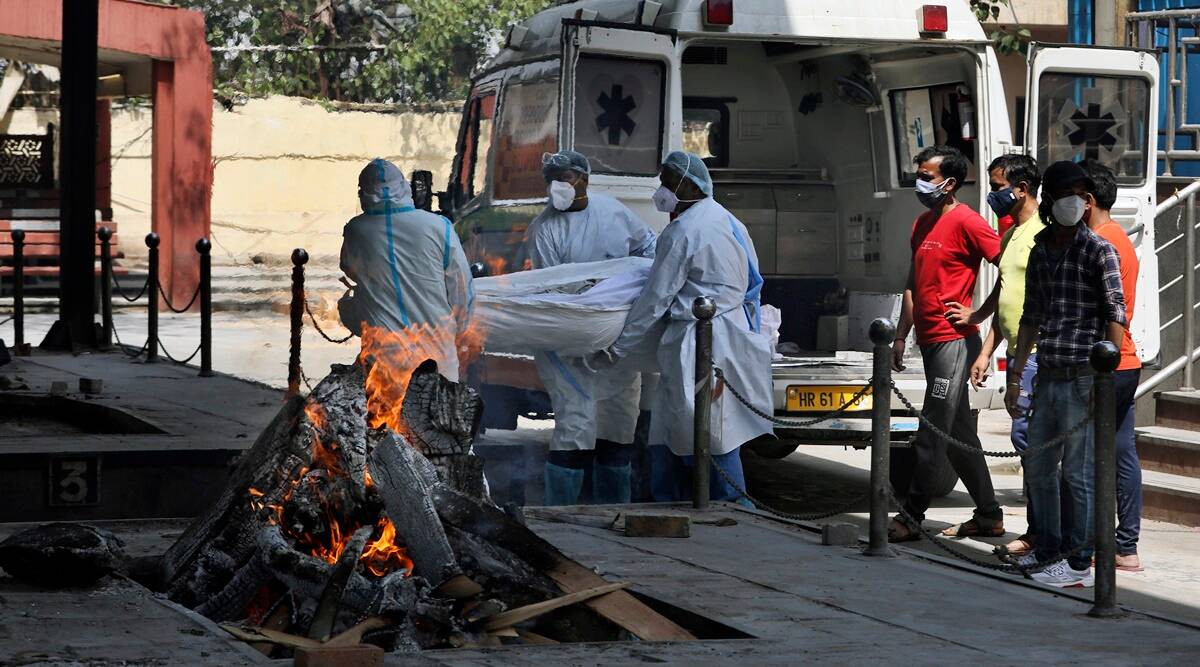 The WHO report said that almost half of the deaths that until now had not been counted were in India. (AP/File)
The WHO report said that almost half of the deaths that until now had not been counted were in India. (AP/File)Covid could have killed as many as 47.4 lakh people in India in 2020 and 2021, either directly due to infection or through its indirect impact, the World Health Organisation said on Thursday. The figure, disputed by India, is nearly ten times the country’s official Covid death toll of 4.81 lakh at the end of 2021.
In its report on excess deaths due to Covid, WHO said that an estimated 1.5 crore people are likely to have succumbed to the direct or indirect impact of the disease globally during the first two years of the pandemic — instead of the 54 lakh that have been recorded officially by countries separately.
For India, the WHO said about 8.3 lakh deaths are estimated to have happened in 2020 itself.
The numbers come just two days after India released its annual data for registration of births and deaths for the year 2020, recorded in its civil registration system (CRS), which showed about 4.75 lakh more deaths than in previous years, consistent with the trend of rising registrations being seen over the last few years. The CRS does not record cause-specific mortality.
Best of Express Premium
The Government has repeatedly objected to the process and methodology adopted by the WHO to calculate the excess deaths, and had sent at least ten letters to the global organisation in this regard. On Thursday, the Government said in a statement, “WHO has released the excess mortality estimates without adequately addressing India’s concerns.”
According to WHO, nearly 84 per cent of the total number of excess deaths happened in South East Asia, Europe, and the Americas.
The high-income countries account for 15 per cent of these deaths, upper middle income countries 28 per cent, lower middle income countries 53 per cent, and low income countries 4 per cent, as per the report.
India alone accounted for a third of the total numbers, according to WHO. Among other countries in the region, Pakistan accounted for 1.54 per cent (230,440) of excess deaths, Bangladesh 0.9 per cent (140,765) and Myanmar 0.29 per cent (44,187). Countries such as Sri Lanka (-8,833) and China (-52,063) reported a negative total, meaning fewer people died there during the pandemic years than earlier.
According to WHO, the deaths linked indirectly to Covid are those that happened due to conditions for which people were unable to access treatment because the health systems were overburdened by the pandemic. It also accounts for fewer deaths due to road accidents, etc., when lockdowns were in place.
“These sobering data not only point to the impact of the pandemic but also to the need for all countries to invest in more resilient health systems that can sustain essential health services during crises, including stronger health information systems,” said Dr Tedros Adhanom Ghebreyesus, WHO Director-General.
A statement from the Union Health Ministry stated: “In view of the availability of authentic data published through Civil Registration System (CRS) by Registrar General of India (RGI), mathematical models should not be used for projecting excess mortality numbers for India.”
Sources in the Ministry said this data was provided to the WHO on the same day it was published on May 3. They said the WHO has conveyed that it will take three months to process the data and include it in the report.
The CRS data for 2021 is scheduled to be released next year.
The WHO states in its report that the “estimates may not be regarded as the national statistics officially produced by India due to differences arising from the data and methods used by WHO”.
According to the Government, India has “consistently questioned WHO’s own admission that data in respect of 17 Indian states was obtained from some websites and media reports and was used in their mathematical model. This reflects a statistically unsound and scientifically questionable methodology of data collection for making excess mortality projections in case of India”.
It has also questioned its placement in Tier II of countries for which national and sub-national level data wasn’t available, and the use of a “one size fits all” model that is unlikely to account for variations in waxing and waning Covid waves.
Speaking about the recently released CRS data, NITI Aayog member Dr V K Paul had told The Indian Express: “This is the total envelop within which you are talking of excess mortality and therefore the Covid-19 toll cannot be in some exorbitant multiple.”
The Health Ministry said: “Despite communicating this data to WHO for supporting their publication, WHO for reasons best known to them conveniently chose to ignore the available data submitted by India and published the excess mortality estimates for which the methodology, source of data, and the outcomes has been consistently questioned by India.”
Sources in the Ministry questioned why their technical experts were not allowed to verify the data. “How can a member state-driven organisation collect data from other sources, even when government data is available? Why were only 17 states selected? Why did the estimated number of deaths keep jumping from 13 lakh to 33 lakh to 63 lakh and then 47 lakh?” sources said.
“Did they collect data over a time period or model the monthly excess mortality based on data from an instance? For example, if mortality from Kerala or Maharashtra is extrapolated for the whole country, it would be wrong because those two states saw high mortality throughout the year. Or, if data from the peak of the second wave is extrapolated for the entire country over the two years, it will give an unusually high number,” sources said.
- The Indian Express website has been rated GREEN for its credibility and trustworthiness by Newsguard, a global service that rates news sources for their journalistic standards.

